Analyzing Conflict Situations and Leadership Styles in Nursing
VerifiedAdded on 2020/10/22
|10
|2598
|296
Report
AI Summary
This report examines a conflict scenario within a nursing organization, detailing the events that led to the dispute between management and nursing staff. It analyzes the charge nurse's position and the measures applied to seek immediate resolution, emphasizing timely action, understanding the root causes, and effective communication. The report identifies collaborative leadership as the most suitable style for conflict management, highlighting its ability to foster win-win solutions and build trust. It also assesses the outcomes for both patients and staff, including impacts on service quality, patient satisfaction, and staff morale, as well as the changes that took place after the conflict's resolution. The report concludes with recommendations for preventing future conflicts, such as improved policies, trust-building initiatives, stress reduction strategies, and flexible scheduling to enhance staff satisfaction and collaboration. This document is a valuable resource for students on Desklib seeking to understand conflict management in healthcare settings.
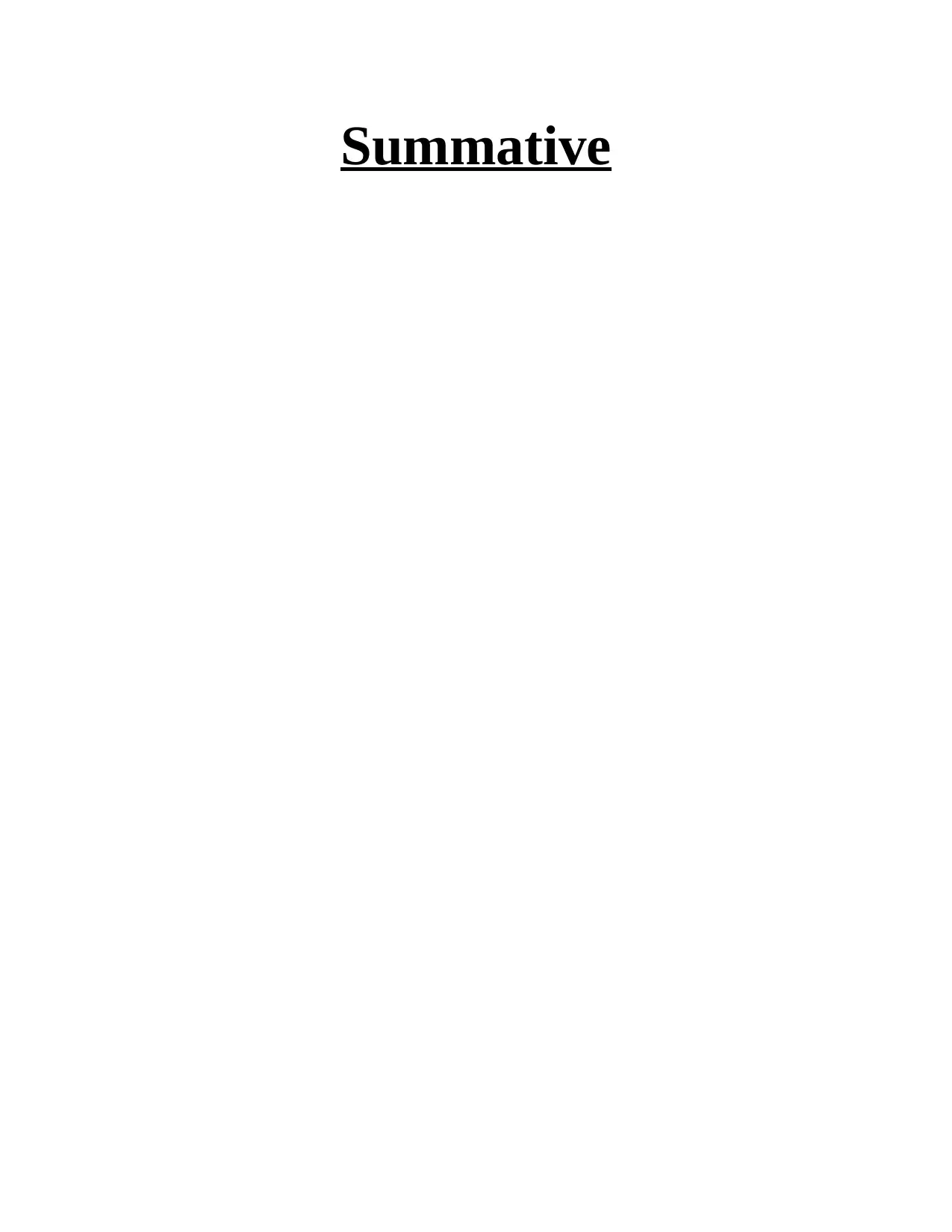
Summative
Paraphrase This Document
Need a fresh take? Get an instant paraphrase of this document with our AI Paraphraser
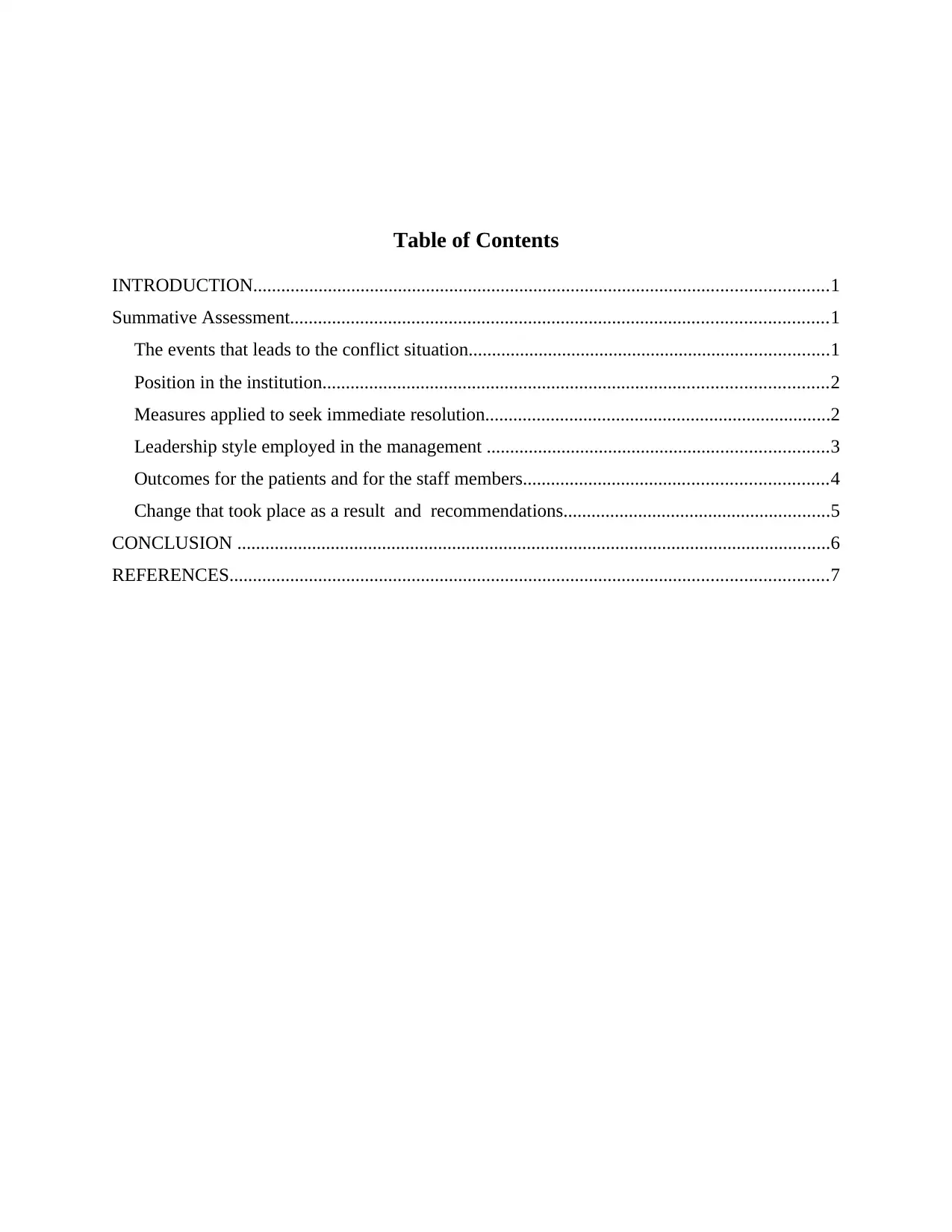
Table of Contents
INTRODUCTION...........................................................................................................................1
Summative Assessment...................................................................................................................1
The events that leads to the conflict situation.............................................................................1
Position in the institution............................................................................................................2
Measures applied to seek immediate resolution..........................................................................2
Leadership style employed in the management .........................................................................3
Outcomes for the patients and for the staff members.................................................................4
Change that took place as a result and recommendations.........................................................5
CONCLUSION ...............................................................................................................................6
REFERENCES................................................................................................................................7
INTRODUCTION...........................................................................................................................1
Summative Assessment...................................................................................................................1
The events that leads to the conflict situation.............................................................................1
Position in the institution............................................................................................................2
Measures applied to seek immediate resolution..........................................................................2
Leadership style employed in the management .........................................................................3
Outcomes for the patients and for the staff members.................................................................4
Change that took place as a result and recommendations.........................................................5
CONCLUSION ...............................................................................................................................6
REFERENCES................................................................................................................................7

⊘ This is a preview!⊘
Do you want full access?
Subscribe today to unlock all pages.

Trusted by 1+ million students worldwide
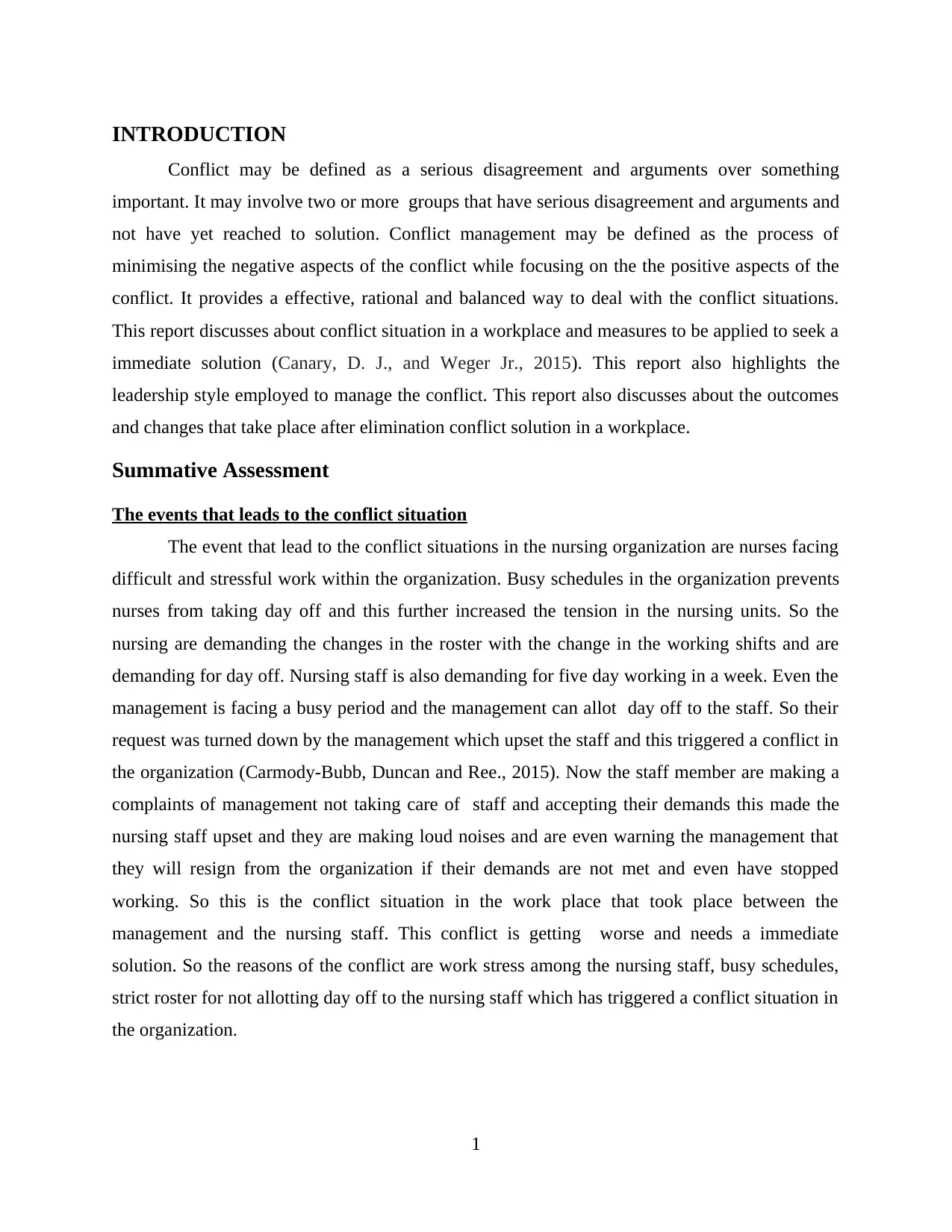
INTRODUCTION
Conflict may be defined as a serious disagreement and arguments over something
important. It may involve two or more groups that have serious disagreement and arguments and
not have yet reached to solution. Conflict management may be defined as the process of
minimising the negative aspects of the conflict while focusing on the the positive aspects of the
conflict. It provides a effective, rational and balanced way to deal with the conflict situations.
This report discusses about conflict situation in a workplace and measures to be applied to seek a
immediate solution (Canary, D. J., and Weger Jr., 2015). This report also highlights the
leadership style employed to manage the conflict. This report also discusses about the outcomes
and changes that take place after elimination conflict solution in a workplace.
Summative Assessment
The events that leads to the conflict situation
The event that lead to the conflict situations in the nursing organization are nurses facing
difficult and stressful work within the organization. Busy schedules in the organization prevents
nurses from taking day off and this further increased the tension in the nursing units. So the
nursing are demanding the changes in the roster with the change in the working shifts and are
demanding for day off. Nursing staff is also demanding for five day working in a week. Even the
management is facing a busy period and the management can allot day off to the staff. So their
request was turned down by the management which upset the staff and this triggered a conflict in
the organization (Carmody-Bubb, Duncan and Ree., 2015). Now the staff member are making a
complaints of management not taking care of staff and accepting their demands this made the
nursing staff upset and they are making loud noises and are even warning the management that
they will resign from the organization if their demands are not met and even have stopped
working. So this is the conflict situation in the work place that took place between the
management and the nursing staff. This conflict is getting worse and needs a immediate
solution. So the reasons of the conflict are work stress among the nursing staff, busy schedules,
strict roster for not allotting day off to the nursing staff which has triggered a conflict situation in
the organization.
1
Conflict may be defined as a serious disagreement and arguments over something
important. It may involve two or more groups that have serious disagreement and arguments and
not have yet reached to solution. Conflict management may be defined as the process of
minimising the negative aspects of the conflict while focusing on the the positive aspects of the
conflict. It provides a effective, rational and balanced way to deal with the conflict situations.
This report discusses about conflict situation in a workplace and measures to be applied to seek a
immediate solution (Canary, D. J., and Weger Jr., 2015). This report also highlights the
leadership style employed to manage the conflict. This report also discusses about the outcomes
and changes that take place after elimination conflict solution in a workplace.
Summative Assessment
The events that leads to the conflict situation
The event that lead to the conflict situations in the nursing organization are nurses facing
difficult and stressful work within the organization. Busy schedules in the organization prevents
nurses from taking day off and this further increased the tension in the nursing units. So the
nursing are demanding the changes in the roster with the change in the working shifts and are
demanding for day off. Nursing staff is also demanding for five day working in a week. Even the
management is facing a busy period and the management can allot day off to the staff. So their
request was turned down by the management which upset the staff and this triggered a conflict in
the organization (Carmody-Bubb, Duncan and Ree., 2015). Now the staff member are making a
complaints of management not taking care of staff and accepting their demands this made the
nursing staff upset and they are making loud noises and are even warning the management that
they will resign from the organization if their demands are not met and even have stopped
working. So this is the conflict situation in the work place that took place between the
management and the nursing staff. This conflict is getting worse and needs a immediate
solution. So the reasons of the conflict are work stress among the nursing staff, busy schedules,
strict roster for not allotting day off to the nursing staff which has triggered a conflict situation in
the organization.
1
Paraphrase This Document
Need a fresh take? Get an instant paraphrase of this document with our AI Paraphraser
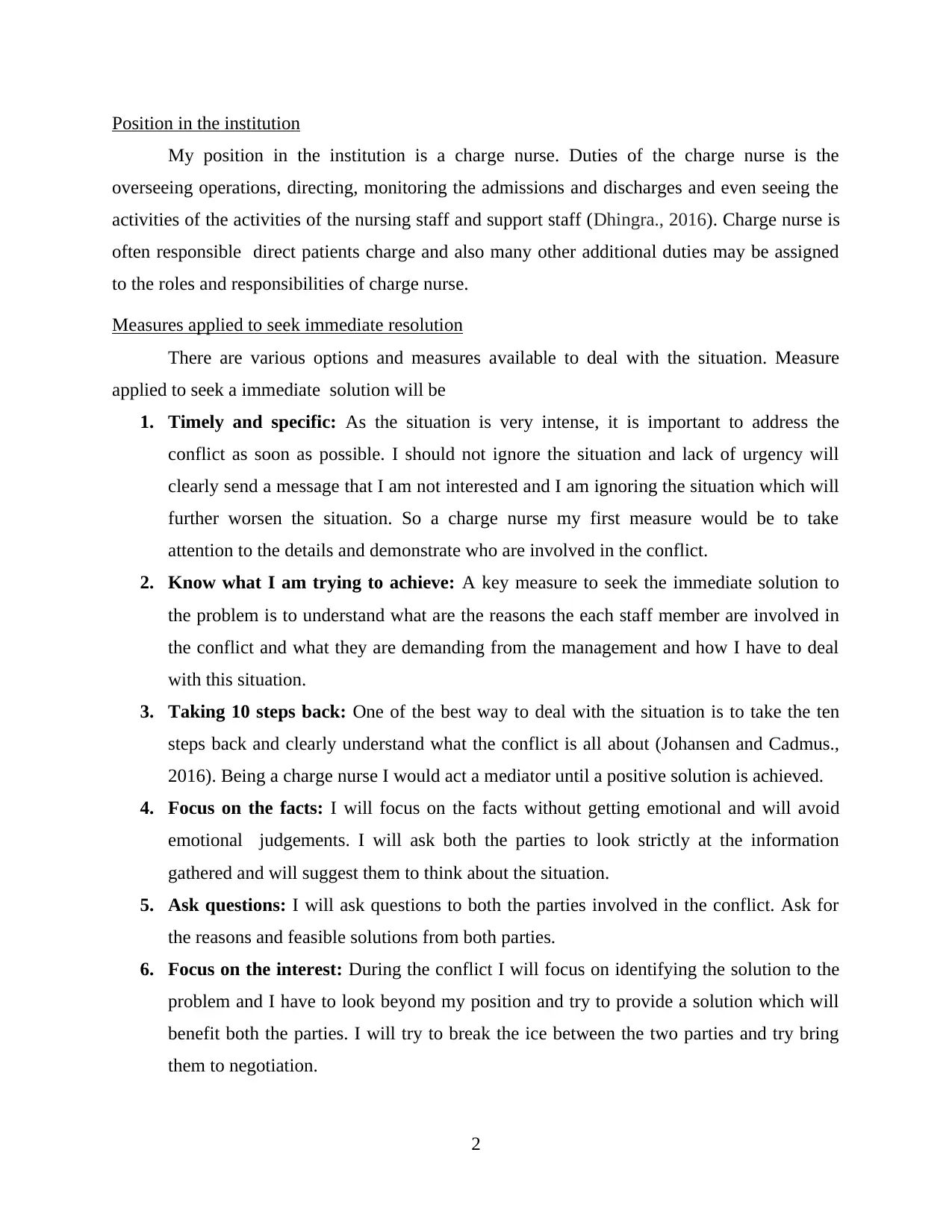
Position in the institution
My position in the institution is a charge nurse. Duties of the charge nurse is the
overseeing operations, directing, monitoring the admissions and discharges and even seeing the
activities of the activities of the nursing staff and support staff (Dhingra., 2016). Charge nurse is
often responsible direct patients charge and also many other additional duties may be assigned
to the roles and responsibilities of charge nurse.
Measures applied to seek immediate resolution
There are various options and measures available to deal with the situation. Measure
applied to seek a immediate solution will be
1. Timely and specific: As the situation is very intense, it is important to address the
conflict as soon as possible. I should not ignore the situation and lack of urgency will
clearly send a message that I am not interested and I am ignoring the situation which will
further worsen the situation. So a charge nurse my first measure would be to take
attention to the details and demonstrate who are involved in the conflict.
2. Know what I am trying to achieve: A key measure to seek the immediate solution to
the problem is to understand what are the reasons the each staff member are involved in
the conflict and what they are demanding from the management and how I have to deal
with this situation.
3. Taking 10 steps back: One of the best way to deal with the situation is to take the ten
steps back and clearly understand what the conflict is all about (Johansen and Cadmus.,
2016). Being a charge nurse I would act a mediator until a positive solution is achieved.
4. Focus on the facts: I will focus on the facts without getting emotional and will avoid
emotional judgements. I will ask both the parties to look strictly at the information
gathered and will suggest them to think about the situation.
5. Ask questions: I will ask questions to both the parties involved in the conflict. Ask for
the reasons and feasible solutions from both parties.
6. Focus on the interest: During the conflict I will focus on identifying the solution to the
problem and I have to look beyond my position and try to provide a solution which will
benefit both the parties. I will try to break the ice between the two parties and try bring
them to negotiation.
2
My position in the institution is a charge nurse. Duties of the charge nurse is the
overseeing operations, directing, monitoring the admissions and discharges and even seeing the
activities of the activities of the nursing staff and support staff (Dhingra., 2016). Charge nurse is
often responsible direct patients charge and also many other additional duties may be assigned
to the roles and responsibilities of charge nurse.
Measures applied to seek immediate resolution
There are various options and measures available to deal with the situation. Measure
applied to seek a immediate solution will be
1. Timely and specific: As the situation is very intense, it is important to address the
conflict as soon as possible. I should not ignore the situation and lack of urgency will
clearly send a message that I am not interested and I am ignoring the situation which will
further worsen the situation. So a charge nurse my first measure would be to take
attention to the details and demonstrate who are involved in the conflict.
2. Know what I am trying to achieve: A key measure to seek the immediate solution to
the problem is to understand what are the reasons the each staff member are involved in
the conflict and what they are demanding from the management and how I have to deal
with this situation.
3. Taking 10 steps back: One of the best way to deal with the situation is to take the ten
steps back and clearly understand what the conflict is all about (Johansen and Cadmus.,
2016). Being a charge nurse I would act a mediator until a positive solution is achieved.
4. Focus on the facts: I will focus on the facts without getting emotional and will avoid
emotional judgements. I will ask both the parties to look strictly at the information
gathered and will suggest them to think about the situation.
5. Ask questions: I will ask questions to both the parties involved in the conflict. Ask for
the reasons and feasible solutions from both parties.
6. Focus on the interest: During the conflict I will focus on identifying the solution to the
problem and I have to look beyond my position and try to provide a solution which will
benefit both the parties. I will try to break the ice between the two parties and try bring
them to negotiation.
2
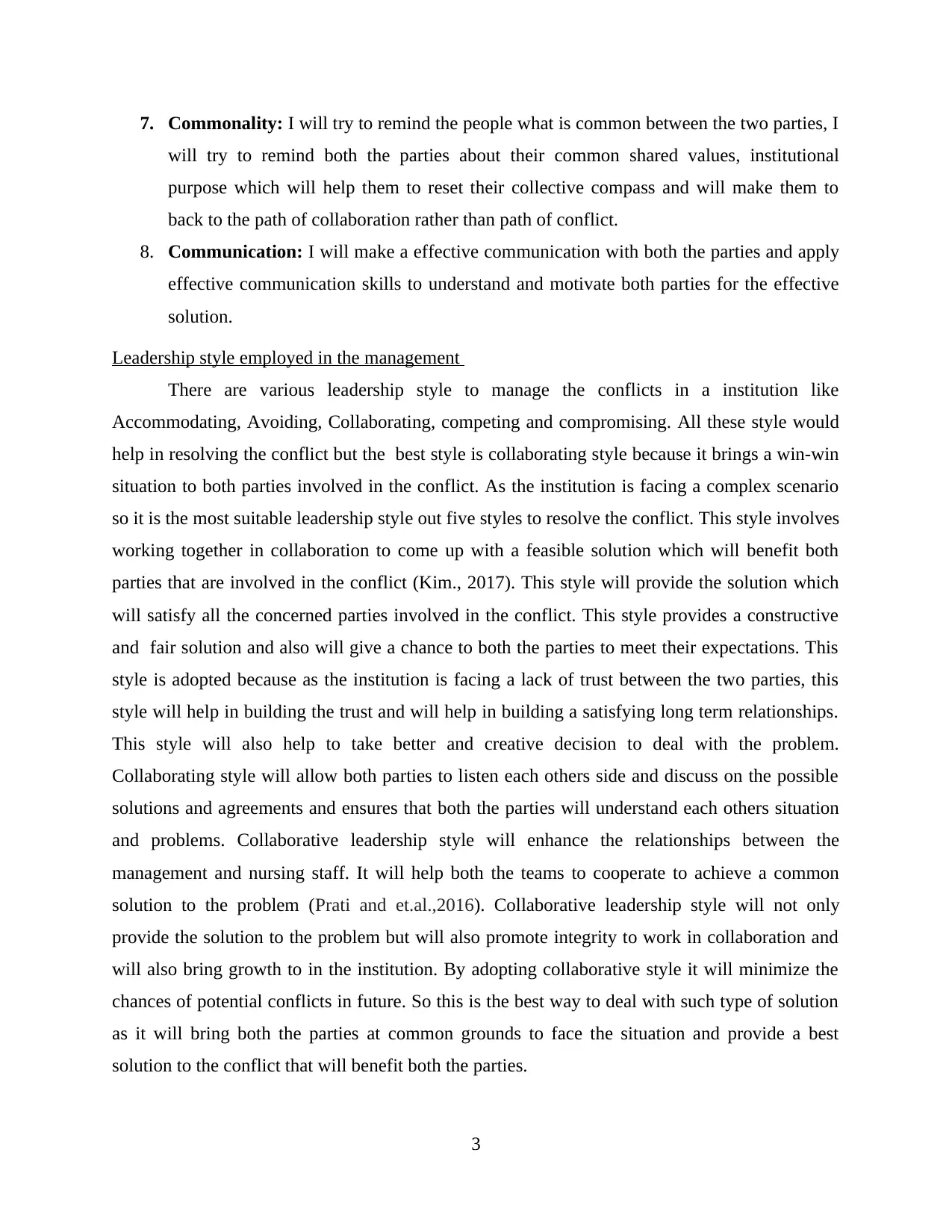
7. Commonality: I will try to remind the people what is common between the two parties, I
will try to remind both the parties about their common shared values, institutional
purpose which will help them to reset their collective compass and will make them to
back to the path of collaboration rather than path of conflict.
8. Communication: I will make a effective communication with both the parties and apply
effective communication skills to understand and motivate both parties for the effective
solution.
Leadership style employed in the management
There are various leadership style to manage the conflicts in a institution like
Accommodating, Avoiding, Collaborating, competing and compromising. All these style would
help in resolving the conflict but the best style is collaborating style because it brings a win-win
situation to both parties involved in the conflict. As the institution is facing a complex scenario
so it is the most suitable leadership style out five styles to resolve the conflict. This style involves
working together in collaboration to come up with a feasible solution which will benefit both
parties that are involved in the conflict (Kim., 2017). This style will provide the solution which
will satisfy all the concerned parties involved in the conflict. This style provides a constructive
and fair solution and also will give a chance to both the parties to meet their expectations. This
style is adopted because as the institution is facing a lack of trust between the two parties, this
style will help in building the trust and will help in building a satisfying long term relationships.
This style will also help to take better and creative decision to deal with the problem.
Collaborating style will allow both parties to listen each others side and discuss on the possible
solutions and agreements and ensures that both the parties will understand each others situation
and problems. Collaborative leadership style will enhance the relationships between the
management and nursing staff. It will help both the teams to cooperate to achieve a common
solution to the problem (Prati and et.al.,2016). Collaborative leadership style will not only
provide the solution to the problem but will also promote integrity to work in collaboration and
will also bring growth to in the institution. By adopting collaborative style it will minimize the
chances of potential conflicts in future. So this is the best way to deal with such type of solution
as it will bring both the parties at common grounds to face the situation and provide a best
solution to the conflict that will benefit both the parties.
3
will try to remind both the parties about their common shared values, institutional
purpose which will help them to reset their collective compass and will make them to
back to the path of collaboration rather than path of conflict.
8. Communication: I will make a effective communication with both the parties and apply
effective communication skills to understand and motivate both parties for the effective
solution.
Leadership style employed in the management
There are various leadership style to manage the conflicts in a institution like
Accommodating, Avoiding, Collaborating, competing and compromising. All these style would
help in resolving the conflict but the best style is collaborating style because it brings a win-win
situation to both parties involved in the conflict. As the institution is facing a complex scenario
so it is the most suitable leadership style out five styles to resolve the conflict. This style involves
working together in collaboration to come up with a feasible solution which will benefit both
parties that are involved in the conflict (Kim., 2017). This style will provide the solution which
will satisfy all the concerned parties involved in the conflict. This style provides a constructive
and fair solution and also will give a chance to both the parties to meet their expectations. This
style is adopted because as the institution is facing a lack of trust between the two parties, this
style will help in building the trust and will help in building a satisfying long term relationships.
This style will also help to take better and creative decision to deal with the problem.
Collaborating style will allow both parties to listen each others side and discuss on the possible
solutions and agreements and ensures that both the parties will understand each others situation
and problems. Collaborative leadership style will enhance the relationships between the
management and nursing staff. It will help both the teams to cooperate to achieve a common
solution to the problem (Prati and et.al.,2016). Collaborative leadership style will not only
provide the solution to the problem but will also promote integrity to work in collaboration and
will also bring growth to in the institution. By adopting collaborative style it will minimize the
chances of potential conflicts in future. So this is the best way to deal with such type of solution
as it will bring both the parties at common grounds to face the situation and provide a best
solution to the conflict that will benefit both the parties.
3
⊘ This is a preview!⊘
Do you want full access?
Subscribe today to unlock all pages.

Trusted by 1+ million students worldwide
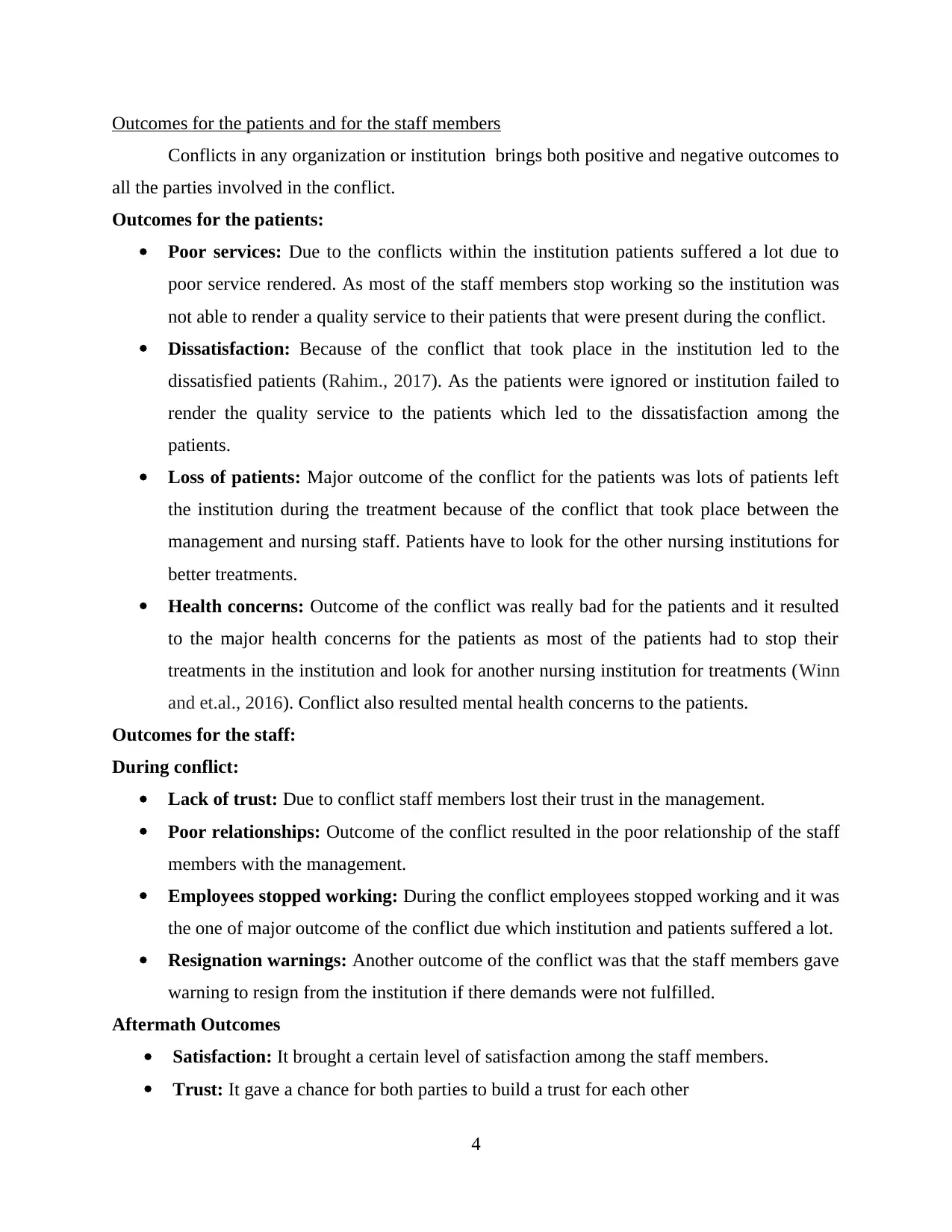
Outcomes for the patients and for the staff members
Conflicts in any organization or institution brings both positive and negative outcomes to
all the parties involved in the conflict.
Outcomes for the patients:
Poor services: Due to the conflicts within the institution patients suffered a lot due to
poor service rendered. As most of the staff members stop working so the institution was
not able to render a quality service to their patients that were present during the conflict.
Dissatisfaction: Because of the conflict that took place in the institution led to the
dissatisfied patients (Rahim., 2017). As the patients were ignored or institution failed to
render the quality service to the patients which led to the dissatisfaction among the
patients.
Loss of patients: Major outcome of the conflict for the patients was lots of patients left
the institution during the treatment because of the conflict that took place between the
management and nursing staff. Patients have to look for the other nursing institutions for
better treatments.
Health concerns: Outcome of the conflict was really bad for the patients and it resulted
to the major health concerns for the patients as most of the patients had to stop their
treatments in the institution and look for another nursing institution for treatments (Winn
and et.al., 2016). Conflict also resulted mental health concerns to the patients.
Outcomes for the staff:
During conflict:
Lack of trust: Due to conflict staff members lost their trust in the management.
Poor relationships: Outcome of the conflict resulted in the poor relationship of the staff
members with the management.
Employees stopped working: During the conflict employees stopped working and it was
the one of major outcome of the conflict due which institution and patients suffered a lot.
Resignation warnings: Another outcome of the conflict was that the staff members gave
warning to resign from the institution if there demands were not fulfilled.
Aftermath Outcomes
Satisfaction: It brought a certain level of satisfaction among the staff members.
Trust: It gave a chance for both parties to build a trust for each other
4
Conflicts in any organization or institution brings both positive and negative outcomes to
all the parties involved in the conflict.
Outcomes for the patients:
Poor services: Due to the conflicts within the institution patients suffered a lot due to
poor service rendered. As most of the staff members stop working so the institution was
not able to render a quality service to their patients that were present during the conflict.
Dissatisfaction: Because of the conflict that took place in the institution led to the
dissatisfied patients (Rahim., 2017). As the patients were ignored or institution failed to
render the quality service to the patients which led to the dissatisfaction among the
patients.
Loss of patients: Major outcome of the conflict for the patients was lots of patients left
the institution during the treatment because of the conflict that took place between the
management and nursing staff. Patients have to look for the other nursing institutions for
better treatments.
Health concerns: Outcome of the conflict was really bad for the patients and it resulted
to the major health concerns for the patients as most of the patients had to stop their
treatments in the institution and look for another nursing institution for treatments (Winn
and et.al., 2016). Conflict also resulted mental health concerns to the patients.
Outcomes for the staff:
During conflict:
Lack of trust: Due to conflict staff members lost their trust in the management.
Poor relationships: Outcome of the conflict resulted in the poor relationship of the staff
members with the management.
Employees stopped working: During the conflict employees stopped working and it was
the one of major outcome of the conflict due which institution and patients suffered a lot.
Resignation warnings: Another outcome of the conflict was that the staff members gave
warning to resign from the institution if there demands were not fulfilled.
Aftermath Outcomes
Satisfaction: It brought a certain level of satisfaction among the staff members.
Trust: It gave a chance for both parties to build a trust for each other
4
Paraphrase This Document
Need a fresh take? Get an instant paraphrase of this document with our AI Paraphraser
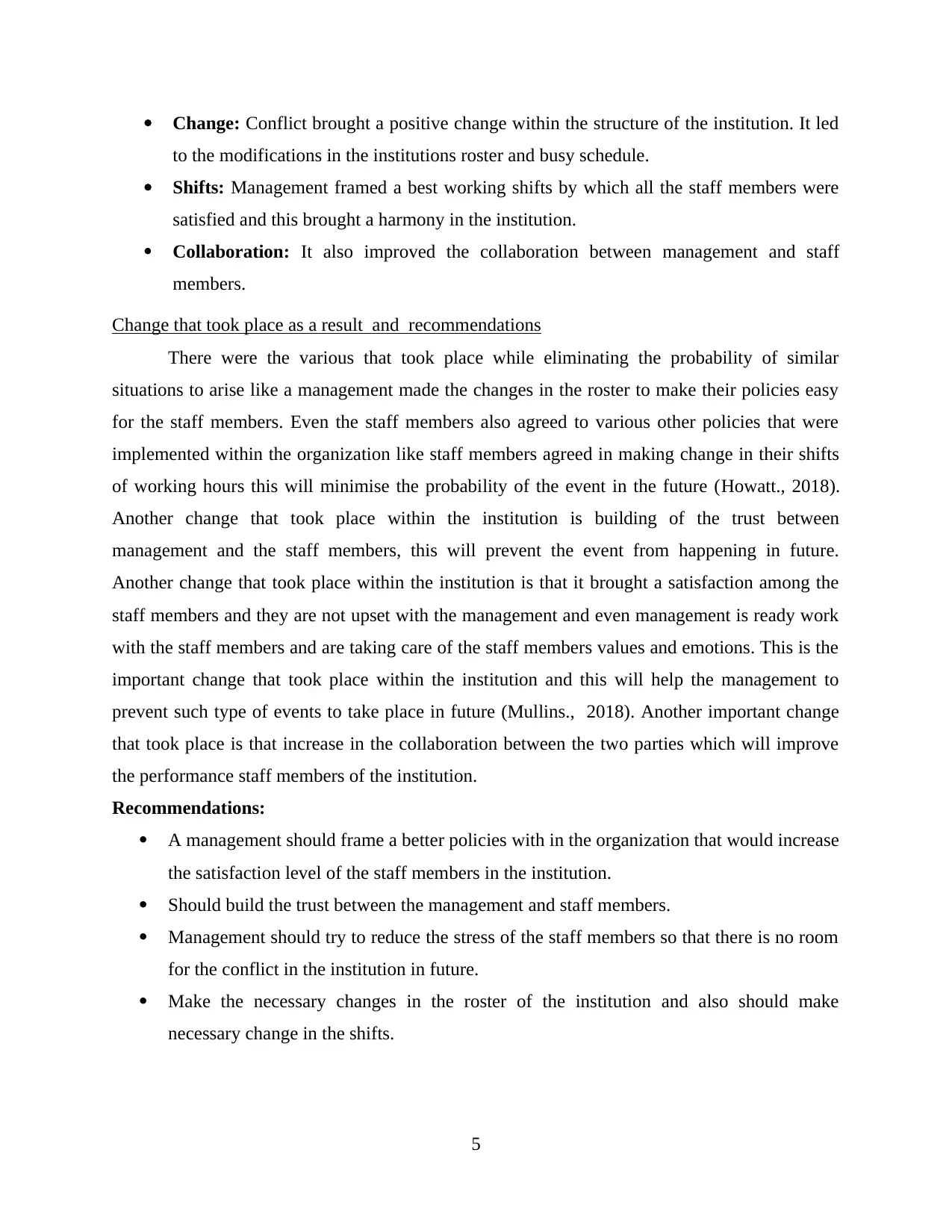
Change: Conflict brought a positive change within the structure of the institution. It led
to the modifications in the institutions roster and busy schedule.
Shifts: Management framed a best working shifts by which all the staff members were
satisfied and this brought a harmony in the institution.
Collaboration: It also improved the collaboration between management and staff
members.
Change that took place as a result and recommendations
There were the various that took place while eliminating the probability of similar
situations to arise like a management made the changes in the roster to make their policies easy
for the staff members. Even the staff members also agreed to various other policies that were
implemented within the organization like staff members agreed in making change in their shifts
of working hours this will minimise the probability of the event in the future (Howatt., 2018).
Another change that took place within the institution is building of the trust between
management and the staff members, this will prevent the event from happening in future.
Another change that took place within the institution is that it brought a satisfaction among the
staff members and they are not upset with the management and even management is ready work
with the staff members and are taking care of the staff members values and emotions. This is the
important change that took place within the institution and this will help the management to
prevent such type of events to take place in future (Mullins., 2018). Another important change
that took place is that increase in the collaboration between the two parties which will improve
the performance staff members of the institution.
Recommendations:
A management should frame a better policies with in the organization that would increase
the satisfaction level of the staff members in the institution.
Should build the trust between the management and staff members.
Management should try to reduce the stress of the staff members so that there is no room
for the conflict in the institution in future.
Make the necessary changes in the roster of the institution and also should make
necessary change in the shifts.
5
to the modifications in the institutions roster and busy schedule.
Shifts: Management framed a best working shifts by which all the staff members were
satisfied and this brought a harmony in the institution.
Collaboration: It also improved the collaboration between management and staff
members.
Change that took place as a result and recommendations
There were the various that took place while eliminating the probability of similar
situations to arise like a management made the changes in the roster to make their policies easy
for the staff members. Even the staff members also agreed to various other policies that were
implemented within the organization like staff members agreed in making change in their shifts
of working hours this will minimise the probability of the event in the future (Howatt., 2018).
Another change that took place within the institution is building of the trust between
management and the staff members, this will prevent the event from happening in future.
Another change that took place within the institution is that it brought a satisfaction among the
staff members and they are not upset with the management and even management is ready work
with the staff members and are taking care of the staff members values and emotions. This is the
important change that took place within the institution and this will help the management to
prevent such type of events to take place in future (Mullins., 2018). Another important change
that took place is that increase in the collaboration between the two parties which will improve
the performance staff members of the institution.
Recommendations:
A management should frame a better policies with in the organization that would increase
the satisfaction level of the staff members in the institution.
Should build the trust between the management and staff members.
Management should try to reduce the stress of the staff members so that there is no room
for the conflict in the institution in future.
Make the necessary changes in the roster of the institution and also should make
necessary change in the shifts.
5
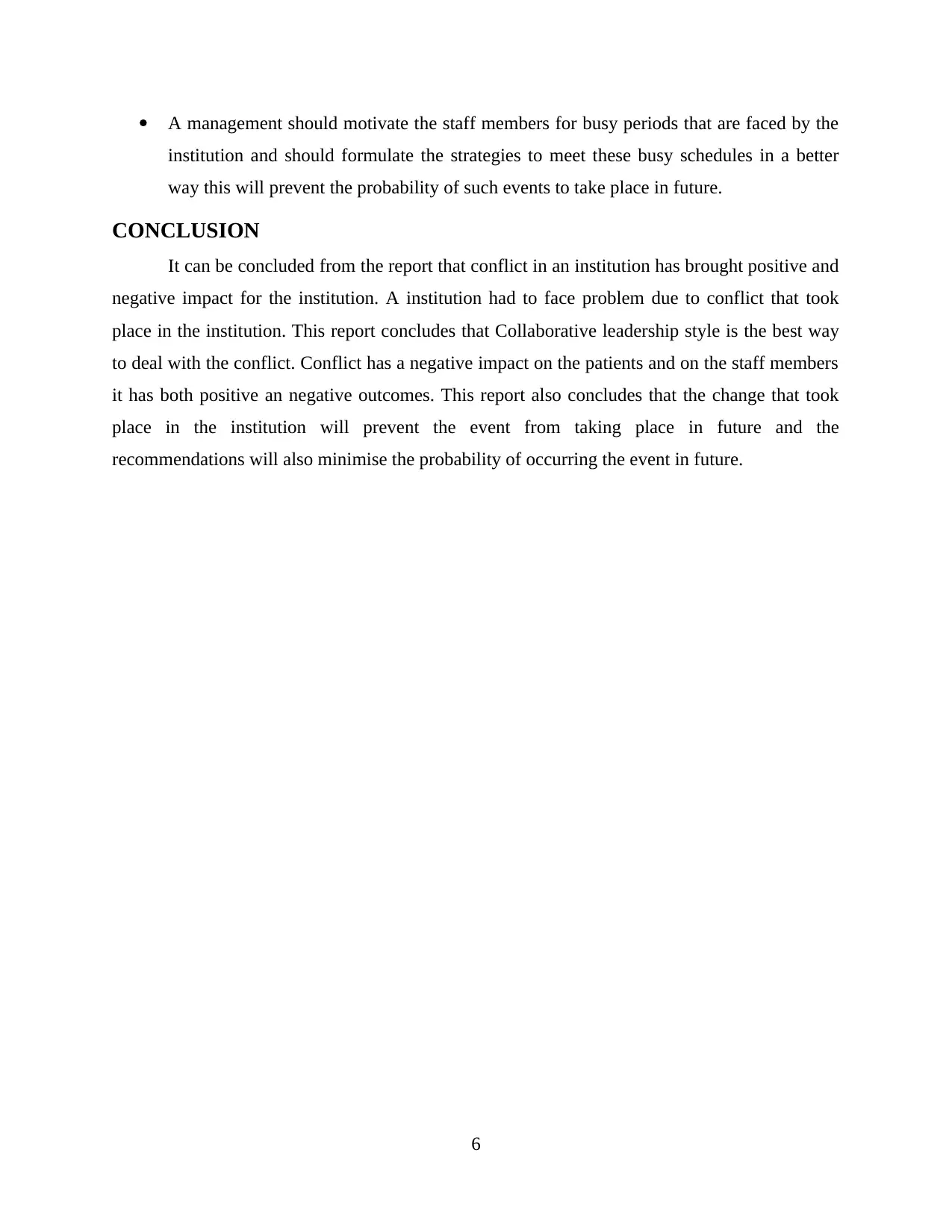
A management should motivate the staff members for busy periods that are faced by the
institution and should formulate the strategies to meet these busy schedules in a better
way this will prevent the probability of such events to take place in future.
CONCLUSION
It can be concluded from the report that conflict in an institution has brought positive and
negative impact for the institution. A institution had to face problem due to conflict that took
place in the institution. This report concludes that Collaborative leadership style is the best way
to deal with the conflict. Conflict has a negative impact on the patients and on the staff members
it has both positive an negative outcomes. This report also concludes that the change that took
place in the institution will prevent the event from taking place in future and the
recommendations will also minimise the probability of occurring the event in future.
6
institution and should formulate the strategies to meet these busy schedules in a better
way this will prevent the probability of such events to take place in future.
CONCLUSION
It can be concluded from the report that conflict in an institution has brought positive and
negative impact for the institution. A institution had to face problem due to conflict that took
place in the institution. This report concludes that Collaborative leadership style is the best way
to deal with the conflict. Conflict has a negative impact on the patients and on the staff members
it has both positive an negative outcomes. This report also concludes that the change that took
place in the institution will prevent the event from taking place in future and the
recommendations will also minimise the probability of occurring the event in future.
6
⊘ This is a preview!⊘
Do you want full access?
Subscribe today to unlock all pages.

Trusted by 1+ million students worldwide
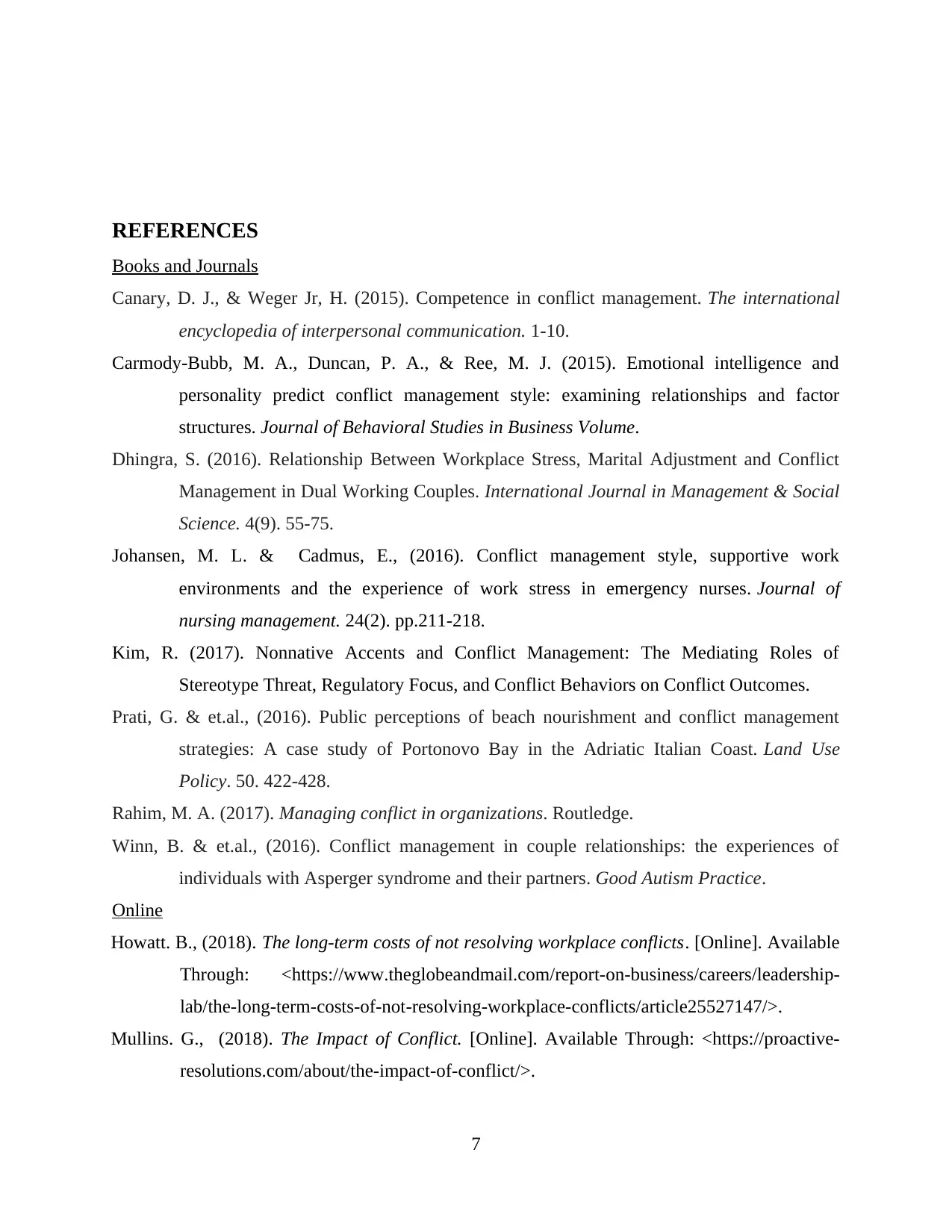
REFERENCES
Books and Journals
Canary, D. J., & Weger Jr, H. (2015). Competence in conflict management. The international
encyclopedia of interpersonal communication. 1-10.
Carmody-Bubb, M. A., Duncan, P. A., & Ree, M. J. (2015). Emotional intelligence and
personality predict conflict management style: examining relationships and factor
structures. Journal of Behavioral Studies in Business Volume.
Dhingra, S. (2016). Relationship Between Workplace Stress, Marital Adjustment and Conflict
Management in Dual Working Couples. International Journal in Management & Social
Science. 4(9). 55-75.
Johansen, M. L. & Cadmus, E., (2016). Conflict management style, supportive work
environments and the experience of work stress in emergency nurses. Journal of
nursing management. 24(2). pp.211-218.
Kim, R. (2017). Nonnative Accents and Conflict Management: The Mediating Roles of
Stereotype Threat, Regulatory Focus, and Conflict Behaviors on Conflict Outcomes.
Prati, G. & et.al., (2016). Public perceptions of beach nourishment and conflict management
strategies: A case study of Portonovo Bay in the Adriatic Italian Coast. Land Use
Policy. 50. 422-428.
Rahim, M. A. (2017). Managing conflict in organizations. Routledge.
Winn, B. & et.al., (2016). Conflict management in couple relationships: the experiences of
individuals with Asperger syndrome and their partners. Good Autism Practice.
Online
Howatt. B., (2018). The long-term costs of not resolving workplace conflicts. [Online]. Available
Through: <https://www.theglobeandmail.com/report-on-business/careers/leadership-
lab/the-long-term-costs-of-not-resolving-workplace-conflicts/article25527147/>.
Mullins. G., (2018). The Impact of Conflict. [Online]. Available Through: <https://proactive-
resolutions.com/about/the-impact-of-conflict/>.
7
Books and Journals
Canary, D. J., & Weger Jr, H. (2015). Competence in conflict management. The international
encyclopedia of interpersonal communication. 1-10.
Carmody-Bubb, M. A., Duncan, P. A., & Ree, M. J. (2015). Emotional intelligence and
personality predict conflict management style: examining relationships and factor
structures. Journal of Behavioral Studies in Business Volume.
Dhingra, S. (2016). Relationship Between Workplace Stress, Marital Adjustment and Conflict
Management in Dual Working Couples. International Journal in Management & Social
Science. 4(9). 55-75.
Johansen, M. L. & Cadmus, E., (2016). Conflict management style, supportive work
environments and the experience of work stress in emergency nurses. Journal of
nursing management. 24(2). pp.211-218.
Kim, R. (2017). Nonnative Accents and Conflict Management: The Mediating Roles of
Stereotype Threat, Regulatory Focus, and Conflict Behaviors on Conflict Outcomes.
Prati, G. & et.al., (2016). Public perceptions of beach nourishment and conflict management
strategies: A case study of Portonovo Bay in the Adriatic Italian Coast. Land Use
Policy. 50. 422-428.
Rahim, M. A. (2017). Managing conflict in organizations. Routledge.
Winn, B. & et.al., (2016). Conflict management in couple relationships: the experiences of
individuals with Asperger syndrome and their partners. Good Autism Practice.
Online
Howatt. B., (2018). The long-term costs of not resolving workplace conflicts. [Online]. Available
Through: <https://www.theglobeandmail.com/report-on-business/careers/leadership-
lab/the-long-term-costs-of-not-resolving-workplace-conflicts/article25527147/>.
Mullins. G., (2018). The Impact of Conflict. [Online]. Available Through: <https://proactive-
resolutions.com/about/the-impact-of-conflict/>.
7
1 out of 10
Related Documents
Your All-in-One AI-Powered Toolkit for Academic Success.
+13062052269
info@desklib.com
Available 24*7 on WhatsApp / Email
![[object Object]](/_next/static/media/star-bottom.7253800d.svg)
Unlock your academic potential
Copyright © 2020–2025 A2Z Services. All Rights Reserved. Developed and managed by ZUCOL.





